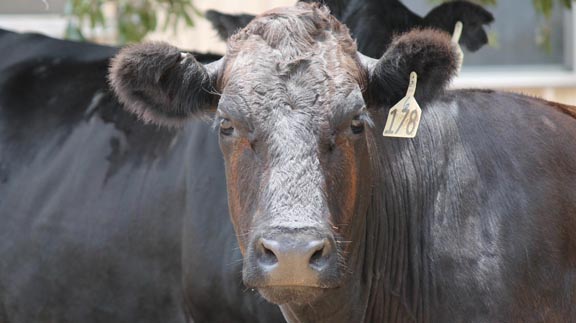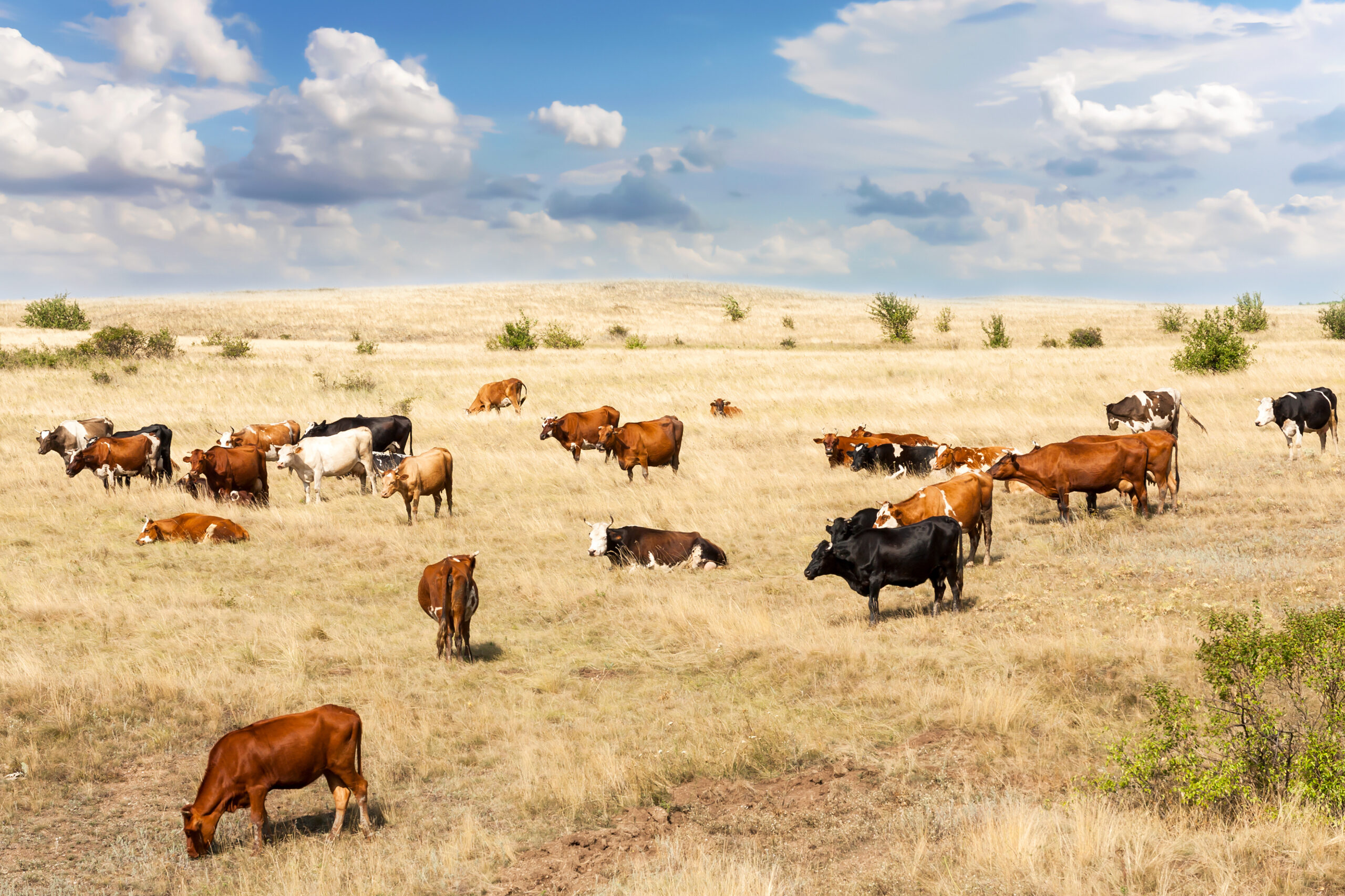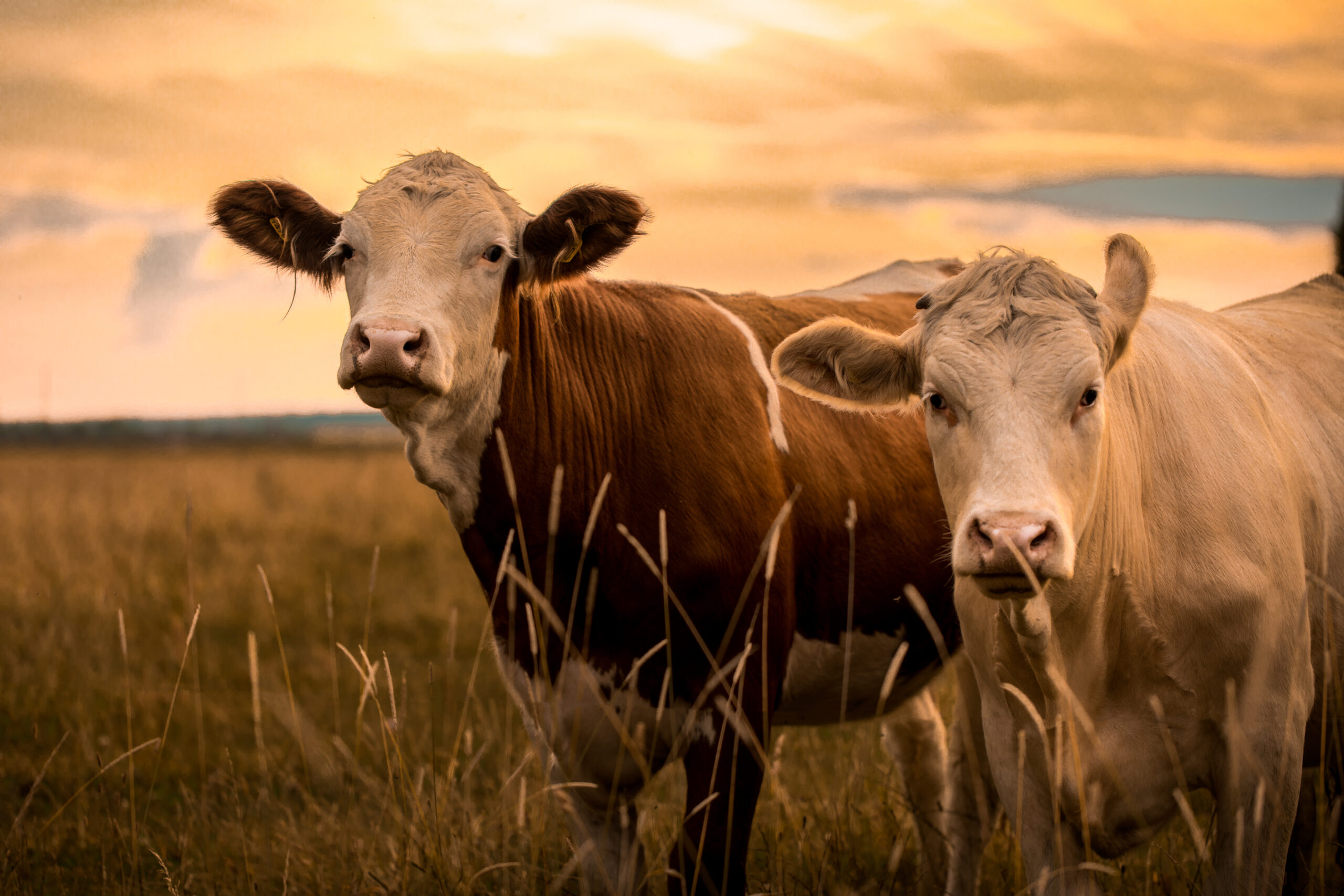Farm & Ranch
Pregnancy testing- Why it’s important and what options are available

By Jessica Crabtree and Dr. Jared Harlan
No matter the breed, the ultimate goal of any cow/calf operations is to have the highest reproductive efficiency. Much like we’ve talked about bulls, cows, too, serve a vital purpose in achieving the objectives of breeding. As producers, pregnancy testing puts them in position to make the best possible decision. With high market prices and cost of feed, each cow must be a producer. If not, she is costing the producer money, especially when selling. Cows sold with a guaranteed live calf attract a higher price at market.
Producers concern themselves with pregnancy testing their cows for multiple reasons. Whether to manage their herds in specific calving periods,helping to determine sire in a artificial insemination program, adding value to cattle going to market, or to cull open cattle. In the latter case, early detection is key in a non-pregnant cow. Early detection of an open cow translates to less input without return. Reliable pregnancy testing can be initiated as early as 6 weeks from the end of a breeding season.
Another major reason is determining the age of the calf and its calving date. With that information, producers can separate early calves from those calving later. This also aids in the culling process, if necessary, to downsize the herd, especially in times of drought. Culling cows based on non-pregnancies is more efficient than basing it off age. This also alleviates stress from calving season. Producers can replace late-calving cows with heifers that conceived early.
Pregnancy testing is also a great way to detect any abnormalities in cows that may cause infertility. Those may include cystic ovaries, uterine infection, injuries from previous deliveries, or anatomical deficiencies. Pregnancy testing is also a way to control diseases that could affect the entire herd along with management problems. For example, if a herd has a low pregnancy rate, it may indicate problems in an individual bull with poor fertility. Poor fertility throughout the herd may be caused from infectious diseases or inadequate nutritional practices. In the case of Trich. Foetus, culling open cows is a major part of the control program.
Pregnancy testing on cattle is typically done by rectal palpation. Rectal palpation can identify a pregnancy as early as six weeks after conception. It is perhaps the most inexpensive and convenient method. When palpating a cow, the veterinarian feels for the calf’s body, a pulse in the artery supplying the blood to the uterus, cotyledons within the uterus, or the embryonic vessicle within the uterus. This is a convenient option due to low cost of equipment, and immediate results. However, modern technology and new techniques have advanced in the production area. An alternative to manual palpation is ultrasound assisted evaluation of the reproductive tract. Portable ultrasonic pregnancy detectors may detect a pregnancy earlier than palpation. Doppler scanners have an external probe containing both transmitting and receiving elements that project a beam of low-energy sound waves. The newest technology includes an extension arm. Essentially, it is a probe that doesn’t have to be taken in to the rectum by hand or arm, reducing fatigue on the operator. Another option and advancement in pregnancy testing in blood testing.
The trans-rectal ultrasound has become a great tool for veterinarians to visualize the embryo or fetus and give additional information beyond rectal palpations. Trans-rectal ultrasound can even determine the sex of the calf, according to Dr. Ram Kasimanickam of Washington State University in the article, Pregnancy Testing: New Technology Provides Several Options. He went on to say that the ultrasound can detect a pregnancy with high accuracy as early as 26 days following breeding.
Ultrasonography works in two ways. The traditional ultrasound is arm-in rectal probe. The new trans-rectal ultrasound extension arm probe eliminates the need for putting an arm into every cow. The technology has been around close to 12 years and was designed to makes work easier for veterinarian’s arms. A pro about the trans- rectal probe is that it is an oscillating probe so the rod doesn’t have to be rotated to view the uterus and its contents. A con to the trans-rectal probe is that veterinarians must be cautious when using it. If there is any sudden or unexpected movement, the rectum could be damaged. There is an advanced version of this called Repro-Scan invented by Dr. Andrew Bronson of Alberta, Canada, with his partner Bruce Hill. Their version uses a convex rectal probe that produces a much larger image. Even with these advancements in technology special training is needed to become accurate with these machines.
Blood testing was developed by Dr. Garth Sasser of the University of Idaho. Dr. Sasser found a protein produced by the placenta and detectable in the blood. It is called Pregnancy Specific Protein B. That evolved into his company called BioTracking and into his blood test called BioPry, (Pregnant ruminant yes/no) in 2002. Many believe that drawing a blood sample is actually less stressful for the cattle than other methods of pregnancy detection. In some studies, blood testing has been shown to be more accurate than palpation or ultrasounding, depending on experience drawing blood samples may actually be quicker as well. However turn around time on the test is often several days, which does not allow for decisions to be made while cattle are already gathered. It also requires that each cow be permanently identified. Collecting blood samples is also an easy skill to learn, eliminating the need to schedule a veterinarian. The blood test is done by taking a blood sample from a vein under the tail. Collection supplies are usually provided by the laboratory performing the testing.
Producers may not choose to pregnancy test at all based on expense. Instead they may choose to monitor oestrus (also called estrus) or returns to heat. Once a cow conceives, all but approximately five percent cease to cycle for the duration of the pregnancy. Oestrus detection after the end of the mating period can be a useful alternative to pregnancy testing, though it may come with some inaccuracy. Due to extra labor required when checking signs of heat, oestrus detection is unlikely to substantially reduce the cost of identifying non-pregnant cows over pregnancy testing. Other measures that can be done to test for pregnancy include measuring the levels of progesterone in the blood or milk. Both involve extra labor and cost.
It is important to remember that no method of determining pregnancy status is 100% accurate. Cost, convenience, accuracy, required equipment, and time investment should all be factors you consider when determining the method you choose. All three have specific cases where incorrect results can be obtained. All three can also be extremely accurate depending on the skill of the person performing each task. Discussing these options with your veterinarian can help you make decisions best suited to your program. They can also help you to decide based on their skill and preference. Dr Harlan prefers palpation over other methods for the majority of his clients. With adequate facilities and defined breeding dates an average of 100 cows per hour is easily attained. However when short bred cows are needed to be checked, he prefers to have the ultrasound available, at least for a back up to double check opens. He also believes that blood testing is a good option for smaller groups of cattle, especially when inadequate facilities are available for palpation or if all cattle cannot be gathered at the same time.
In conclusion, producers must seek out the best pregnancy testing method for their individual program based on their herd needs. Of the methods discussed, a producer can find which works to identify non-pregnant cows, fertility problems and management problems that need to be addressed to be efficient and achieve ultimate breeding objectives: happy cows and healthy calves.

Farm & Ranch
Cattle Nematodes (Worms)

Barry Whitworth, DVM | Senior Extension Specialist | Department of Animal & Food Sciences
According to the Mesonet, Oklahoma received some much-needed rain in late April (2023). With the moderate temperatures and high humidity, the environment is perfect for the proliferation of gastrointestinal nematodes (GIN) which are commonly called “worms.” Cattle can be infected with a variety of GIN. Most do not cause issues unless husbandry practices are poor. However certain GIN have been associated with disease. The most pathological GIN in cattle is Ostertagia ostertagi. Cooperia species and Haemonchus species are two that have been implicated with production issues. Control of these parasites is constantly changing due to environment, anthelmintic (dewormer) resistance, and consumer preference. Cattle producers should develop a plan to manage these parasites.
In order for GIN to complete their life cycle, certain environmental conditions must exist. The development stage begins with passing of the egg in the feces of the animal. If the egg is to hatch, the temperature must be warm and the humidity needs to be close to 100%. Ideal temperature ranges from 70⁰ to 80⁰ Fahrenheit (F), but any temperature above 45⁰ F will allow for development. Temperatures above 85⁰ F or below 45⁰ F will begin to hamper development. Humidity needs to be 80% or higher.
Once the egg hatches, the larva goes through a couple of molts to reach the infective stage which is the third stage larva (L3). L3 must have moisture to free itself from the fecal pat. Once free, it rides a wave of water on to a blade of forage. Once ingested, this begins the prepatent or pre-adult stage. Two molts take place during this stage (L3 to L4 and L4 to L5). If conditions are not favorable for survivability of offspring, L4 will go into an arrested development stage (hypobiosis) for a period of time. The patent or adult stage is the mature breeding adult.
Once inside the body, the parasite will migrate to certain locations in the digestive tract. For example, O. ostertagi develop in the gastric gland in the abomasum. H. placei and H. contortus will migrate to the abomasum. Cooperia species will live in the small intestine. A few like Trichuris (whipworms) are found in the large intestine.
Clinical signs of parasitism vary according to the species of parasite, burden, and site of attachment. Severe disease, which is referred to as parasitic gastroenteritis (PGE), with internal parasites is unusual with today’s control methods. Clinical signs of PGE are lack of appetite, weight loss, weakness, diarrhea, submandibular edema (bottle jaw), and death. However, most parasite infection are subclinical which means producers do not see clinical signs of disease. In subclinical infections, the parasite causes production issues such as poor weight gain in young cattle, reduced milk production, and lower pregnancy rates.
Producers should be monitoring their herds for parasites throughout the year but especially in the spring when conditions are ideal for infection. A fecal egg count (FEC) is a good way of accessing parasite burdens. Livestock producers need to gather fecal samples from their herd periodically. The samples should be sent to their veterinarian or a veterinary diagnostic lab. Different techniques are used to access the number of eggs per gram of feces. Based on the counts, the producer will learn the parasite burden of the herd. Producers can use this information to develop a treatment plan.
In the past, GIN control was simple. Cattle were routinely dewormed. Unfortunately, anthelmintic resistance has complicated parasite control. Now proper nutrition, grazing management, a general understanding of how weather influences parasites, biosecurity, refugia, anthelmintic efficiency, and the judicious use of anthelmintics are important in designing an effective parasite management program. All of these considerations need to be discussed in detail with a producer’s veterinarian when developing a plan for their operation.
Cattle producers need to understand that parasites cannot be eliminated. They must be managed with a variety of control methods. Designing a parasite management plan requires producers to gain a general understanding of life cycle of the parasite as well as the environmental needs of the parasite. Producers should use this information as well as consult with their veterinarian for a plan to manage GIN. For more information about GIN, producers should talk with their veterinarian and/or with their local Oklahoma State University Cooperative Extension Agriculture Educator.
References
Charlier, J., Höglund, J., Morgan, E. R., Geldhof, P., Vercruysse, J., & Claerebout, E. (2020). Biology and Epidemiology of Gastrointestinal Nematodes in Cattle. The Veterinary clinics of North America. Food animal practice, 36(1), 1–15.
Navarre C. B. (2020). Epidemiology and Control of Gastrointestinal Nematodes of Cattle in Southern Climates. The Veterinary clinics of North America. Food animal practice, 36(1), 45–57.
Urquhart, G. M., Armour, J., Duncan, J. L., Dunn, A. M., & Jennings, F. W. (1987). In G. M. Urquhart (Ed). Veterinary Helminthology. Veterinary Parasitology (1st ed., pp 3-33). Longman Scientific & Technical.
Farm & Ranch
The Value of Vitamin A

Barry Whitworth, DVM – Area Food/Animal Quality and Health – Specialist for Eastern Oklahoma
A ranch in Australia experienced an abnormally high number of stillbirths and weak born calves in 2004-2005. An investigation revealed that the usual infectious causes were not the problem. After additional testing, veterinarians diagnosed low levels of vitamin A as the cause.
According to Dr. Greg Hanzlicek, with the Kansas State Veterinary Diagnostic Laboratory (KSVDL), Kansas had an unusually high number of stillbirth cases and weak born calves in the spring of 2019. After many laboratory tests, it was concluded that the problem stimmed from a lack of energy, protein, Vitamin A, or combinations of all of these.
Both of the above examples demonstrate the importance of vitamin A in reproductive efficiency. Research has shown that low vitamin A levels during pregnancy are associated with abortions, stillbirths, and weak born calves. In addition to playing an important role in reproductive efficiency, vitamin A is essential for vision, bone growth, and maintaining epithelial tissue such as skin and hooves.
Animals obtain vitamin A from consuming green forage and/or the addition of vitamin A supplements to the diet. Lush green pastures contain high amounts of vitamin A. As plants mature and during times of drought, the amount of vitamin A decreases. The ranch in Australia experienced below average rainfall in the previous two years prior to the calving season. During the calving season, rainfall was below average with very dry conditions and little green forage was available.
In general, animals obtain adequate amounts of vitamin A by grazing green forage. Animals grazing green pastures will build a healthy store of vitamin A in the liver. When vitamin A is in short supply, the stores in the liver prevent deficiencies. According to Dr. Lalman, Extension Beef Cattle Specialist Oklahoma State University, the stores should last 2 to 4 months during times of deficiency. During times when green forage is not available, vitamin A supplements need to be added to the diet to prevent deficiencies.
When vitamin A levels are deficient, night blindness is one of the earliest clinical signs. Other eye issues include clouding of the cornea, ocular discharges, and possible ulcerations. Skin issues found when levels of vitamin A are deficient include a dry rough coat, scales on the skin, and dry cracked hooves. Other neurological signs include incoordination or gait problems. Seizures may occur due to the increase cerebrospinal fluid pressure. Birth defects have also been attributed to low vitamin A levels.
Animals displaying vitamin A deficiency should be treated immediately with vitamin A injections. If treated early, response is usually rapid and complete. However, delaying treatment may result in irreversible damage. Even with treatment, cattle with vision impairment due to vitamin A deficiency may not regain their sight.
Preventing Vitamin A deficiency depends on producers being attentive to the environmental conditions that favor low vitamin A levels in forage. During these times, producers need to supplement the diet with vitamin A. Producers need to be aware that Vitamin A supplements degrade rapidly, so vitamin A supplements should not be stored for long periods of time. In addition to vitamin A supplementation, research indicates that diets low in protein result in poor absorption of vitamin A. It is important that producers ensure that the rations have sufficient protein levels. Lastly, since colostrum contains high levels of vitamin A, producers need to ensure that newborns obtain adequate amounts of colostrum at birth.
Similar to the Australian example, most of Oklahoma had below average rainfall for the year of 2022. This resulted in pasture quality decreasing earlier than normal. Due to this year’s lack of green forage, liver stores of vitamin A may be inadequate for the animal’s needs. Producers need to ensure that the diets of their cattle have adequate amounts of vitamin A, energy, and protein. For more information about Vitamin A, producers should contact their veterinarian and/or visit with their Oklahoma State University County Ag Educator.
References
Hanzlicek, G. (2019, May). Difficult Calving Season Findings:2019. Diagnostic Insights. www.ksudl.org/resources/news/diagnostic_insights/may2019/difficult-calving-season2019.html.
Hill, B., Holroyd, R., & Sullivan, M. (2009). Clinical and pathological findings associated with congenital hypovitaminosis A in extensively grazed beef cattle. Australian Veterinary Journal, 87(3), 94–98.
Parker, E. M., Gardiner, C. P., Kessell, A. E., & Parker, A. J. (2017). Hypovitaminosis A in extensively grazed beef cattle. Australian veterinary journal, 95(3), 80–84.
Farm & Ranch
Lice in Cattle

Barry Whitworth, DVM, MPH | Senior Extension Specialist
Department of Animal & Food Sciences | Freguson College of Agriculture | Oklahoma State University
Cattle lice cost Oklahoma cattlemen millions of dollars each year in decreased weight gains and reduced milk production. If cattle producers have not treated their cattle for lice this fall, they need to consider what type of lice control to initiate. This is especially true for cattle producers that had problems in the previous year. Cattle producers should monitor cattle closely during the months of December, January, and February. Producers should not wait until clinical signs appear before beginning treatment.
The life cycle of the different species of cattle lice are very similar. The life cycle begins with the female louse attaching her egg to a shaft of hair. The egg will hatch as a small replica of the adult. After several molts, the adult will emerge. The cycle takes around 3 to 4 weeks to complete. These newly hatched lice will spend their entire life on the host and are host specific which means cattle cannot be infected with lice from other animals.
Small numbers of lice may be found on cattle in the summer, but high populations of lice are associated with cold weather. Since cattle tend to be in closer proximity to each other in the winter, lice can spread easily between cattle. A small percentage of cattle tend to harbor larger numbers of lice. These animals are sometimes referred to as “carrier animals”, and they may be a source for maintaining lice in the herd. As with many other diseases, stress also contributes to susceptibility and infestation.
Signs of lice infections in cattle are hair loss, unthrifty cattle, and hair on fences or other objects. If producers find these signs, they may want to check a few animals for lice. They can check for lice by parting the hair and observing the number of lice per square inch. If an animal has 1 to 5 lice per square inch, they are considered to have a low infestation. Cattle with 6 to 10 lice would be considered moderately infested. Any cattle with more than 10 lice per square inch are heavily infested.
Cattle have two types of lice. One type is the biting or chewing louse. These lice have mouth parts that are adapted to bite and chew the skin. The second type is sucking louse. These lice have mouth parts that will penetrate the skin and suck blood and other tissue fluids. It is not uncommon for cattle to be infested with more than one species of lice.
The biting or chewing louse is Bovicola (Domalinia) bovis. This type of lice feeds on hair, skin, skin exudate, and debris. Typical clinical signs with this type of louse are hair loss, skin irritation and scabs on the skin. They are found on the shoulders and back.
Four types of sucking lice can be found in the United States. The first is the “short nose” louse or Haematopinus eurysternus. This is the largest cattle louse. This louse is found on the neck, back, dewlap, and base of the tail. The second is the “long-nose” louse or Linognathus vituli. This louse is bluish in color with a long slender head. This louse is found on the dewlap, shoulders, sides of the neck, and rump. The third is the “little blue” louse or Solenoptes cappilatus. This louse is blue in color and is the smallest cattle louse. This louse is found on the dewlap, muzzle, eyes, and neck. The last is the “tail” louse or Haematopinus quadripertuses. This louse has been found in California, Florida, and other Gulf Coast States. This louse is found around the tail.
The sucking lice have the potential to cause severe anemia if the numbers are high. This can result in poor doing cattle or in extreme cases death. They also can spread infectious diseases. The long-nose louse has been found to be a mechanical vector for anaplasmosis.
Prevention of lice infestation should begin in the fall. Producers should not wait for clinical signs to appear before beginning treatment. Several products are available to control lice. Producers should read and follow the label directions. Producers should keep in mind that many of the lice control products require two administrations to control lice. Failure to do this may result in cattle having problems with lice infestations.
Some producers have complained that some products do not work. These complaints have not been verified; however, this is a good reason to consult with a veterinarian for advice on what products to use. Most treatment failures are associated with incorrect application not resistance. Proper application of Pour-On insecticides is to administer from the withers to the tailhead. Also, the proper dose is essential for good control.
Cattle producers need to consider a few other things in lice control. Since cattle in poor body condition are more prone to lice infestation, producers need to be sure that the nutritional needs of their cattle are being met. Cattle that have a history of lice infestations should be culled. Lastly, any purchased cattle need to be inspected for lice before entering the herd. If lice are found, the animals should be isolated and treated before entering the herd.
If producers would like more information on lice in cattle, they should contact their local veterinarian or Oklahoma State University County Extension Agriculture Educator. They may also want to read Oklahoma Cooperative Extension Fact Sheet Beef Ectoparasites VTMD-7000 at https://extension.okstate.edu/fact-sheets/beef-cattle-ectoparasites.html.
-

 Attractions8 years ago
Attractions8 years ago48 Hours in Atoka Remembered
-

 Country Lifestyle9 months ago
Country Lifestyle9 months agoJuly 2017 Profile: J.W. Hart
-

 Country Lifestyle9 years ago
Country Lifestyle9 years agoThe House a Treasure Built
-

 Country Lifestyle4 years ago
Country Lifestyle4 years agoThe Two Sides of Colten Jesse
-

 Outdoors7 years ago
Outdoors7 years agoGrazing Oklahoma: Honey Locust
-

 Equine8 years ago
Equine8 years agoUmbilical Hernia
-

 Outdoors5 years ago
Outdoors5 years agoPecan Production Information: Online Resources for Growers
-

 Farm & Ranch7 years ago
Farm & Ranch7 years agoHackberry (Celtis spp.)



